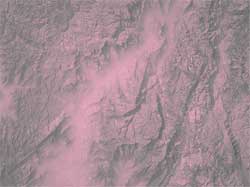Screening smoke
 crew members on the American space shuttle Columbia may have been at a loss when a tethered satellite broke free and drifted away. But for Robert J Charlson, an atmospheric scientist with the University of Washington, Seattle, the aborted mission was a blessing in disguise. The astronauts now had the opportunity to dispatch some photographs of the Earth which has helped Charlson unravel the effect of atmospheric pollution on the world's climate. Although Charlson and his colleagues know that a large part of the haze is made up of sulphates, they have been unable to determine its exact composition. But sulphate haze, normally considered to be a greenhouse gas, is now known to cause climate cooling. Photos of the haze hanging over some industri al areas of our planet have helped Charlson confirm the geographic extent of air pollution in these areas ( Scientific American , Vol 275, No 3).
crew members on the American space shuttle Columbia may have been at a loss when a tethered satellite broke free and drifted away. But for Robert J Charlson, an atmospheric scientist with the University of Washington, Seattle, the aborted mission was a blessing in disguise. The astronauts now had the opportunity to dispatch some photographs of the Earth which has helped Charlson unravel the effect of atmospheric pollution on the world's climate. Although Charlson and his colleagues know that a large part of the haze is made up of sulphates, they have been unable to determine its exact composition. But sulphate haze, normally considered to be a greenhouse gas, is now known to cause climate cooling. Photos of the haze hanging over some industri al areas of our planet have helped Charlson confirm the geographic extent of air pollution in these areas ( Scientific American , Vol 275, No 3).
Sulphur dioxide, a gas commonly emitted by various industries forms sulphate aerosols under clear skies. Sulphates are found to lower the temperature in two ways. They reflect away incoming solar radiation and are also responsible for boosting the number of cloud droplets, thereby increasing cloud reflectivity. These reactions take place in the troposphere, the part of the atmosphere that extends from the earth's surface up to about 10 km. Sulphates could cool to such an extent that they could perhaps effectively counter regional warming caused by such greenhouse gases as carbon dioxide and methane. However, it is important to note that the temperature-lowering effect of sulphate aerosols is only regional. Unlike carbon dioxide, which spreads throughout the atmosphere, sulphur dioxide stays put and only the areas engulfed by it are cooled.
Till now, attempts at quantifying the extent of cooling have been based on theoretical calculations and computer modelling, but the results have varied significantly. The scientists hope that more chemical data on the composition of the haze could make possible precise quantification.
Some of the photographs taken were of the Yangtse river valley in China. Decades of radiometric measurements had shown that the amount of sunlight hitting the area had steadily decreased as the population increased. But it is the photographs that implicate increased levels of sulphate smog as the reason for this. Coal burning in the region is the main generator of the smog. The camera also focussed on other kinds of aerosol clouds, such as the ones that hovered over California's central valley. These clouds were found to contain dust and smoke particles caused by the burning of wood and agricultural waste. Such particles deflect sunlight and increase cloud reflectivity to a greater degree than do sulphate clouds.
Apart from cooling, the haze imparts two other effects that are not so cool: it creates acid rain and depletes the ozone layer.
Related Content
- Cured TB patients run risk of lung disease: Study
- Preventing stroke: uneven progress
- Do lung cancer eligibility criteria align with risk among Blacks and Hispanics?
- Rising cancer rate drives prevention plan
- Common oncogene mutations and novel SND1-BRAF transcript fusion in lung adenocarcinoma from never smokers
- Screening of local plants for their repellent activity against mosquitoes (Diptera: Culicidae)
